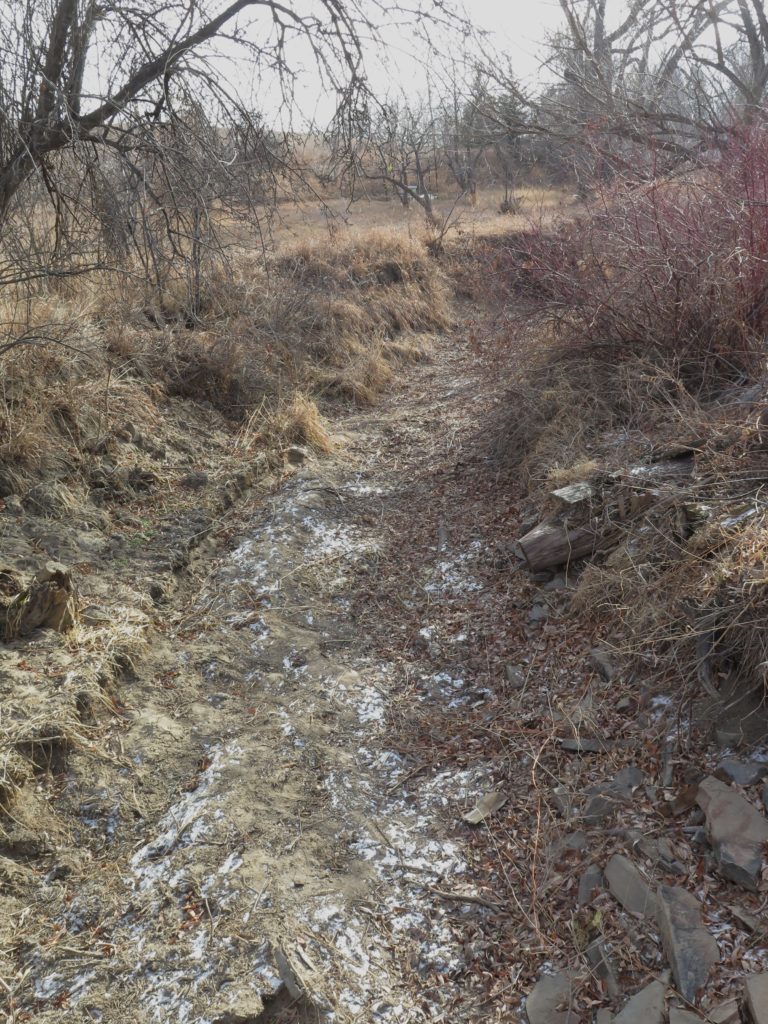Subscribe at the right of this page for a monthly post with writing explorations at the end for creating your own ecobiography.
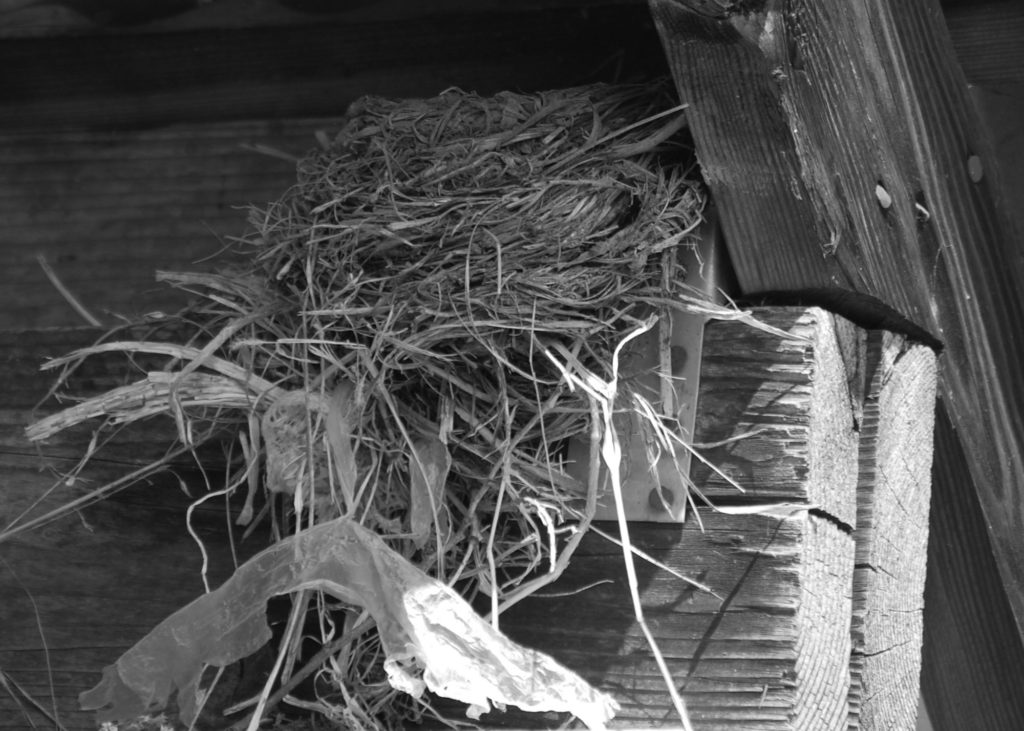
I’m not a birder, but I love observing the many species of birds that take up residence or make a migratory stop on our farm. When I see a bird I can’t identity, I consult one of our talented birding members like our young friend Joel, whose photographs of birds in the wild are as much portraits as they are ornithological research.
Despite needing back-up for the Western Tanager I spotted on a crabapple tree, I do recognize some stand-outs: Lesser goldfinches pay an annual visit to our farm when autumn leaves start to turn, while bald eagles are regular visitors here, along with red-tailed hawks and a pair of great-horned owls that sometimes nest in our trees. Common birds like house wrens, mourning doves, blue jays, magpies, and starlings are in residence, too, some building nests in inconvenient places like tool racks, downspouts, and barn walls.
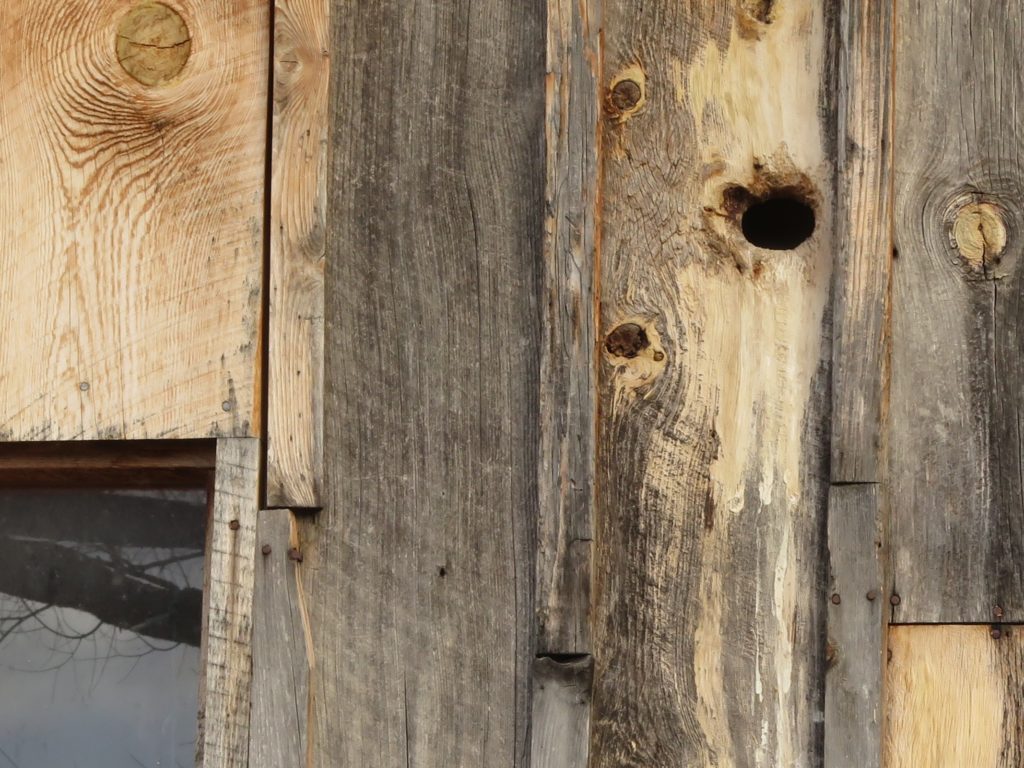
Once, a robin built a nest on the bristles of a push broom leaned upside-down against the tractor barn, the tip of its wooden handle balanced on the slim edge of a pail. We assumed that the nest was attached to the rough wall against which it rested. Everyday when we passed that broom, we wondered when the whole contraption would fall. We worried about the eggs so precariously perched as the mother flew protectively to and from the nest.
While we watched the robin nesting for days on that broom, we shared a parent’s concern for the future of its young. After the babies hatched and fledged, we were relieved. Then we discovered the nest was simply resting on the broom, not affixed to the wall in any way. How easily that nest might have blown down in the wind or fallen as the fledglings pushed off on their first flight. The happy outcome seemed to attest to the robin’s skill—and some luck that we wouldn’t need our broom or pail.

The answer to the question, “If you were a bird, where would you nest?” depends on what type of bird you choose to be. According to their habitat and breeding practices, birds build as many different kinds of nests as there are species. Most birds nest once per year, but robins may have 4 or 5 nests during a breeding season (maybe because they build nests in precarious places?).
In fact, not all birds build nests or live in them regularly. Some birds lay eggs on the ground or on ledges. Others, like cuckoos, lay eggs in other birds’ nests. Around our farm, birds often nest inside tall trees. We see the holes pecked by flickers and downy woodpeckers, but not the nests or young. For birds, nesting has one purpose: breeding to produce the next generation. Nests provide a place for eggs to be laid and hatched and to keep chicks safe until they are ready to fledge.
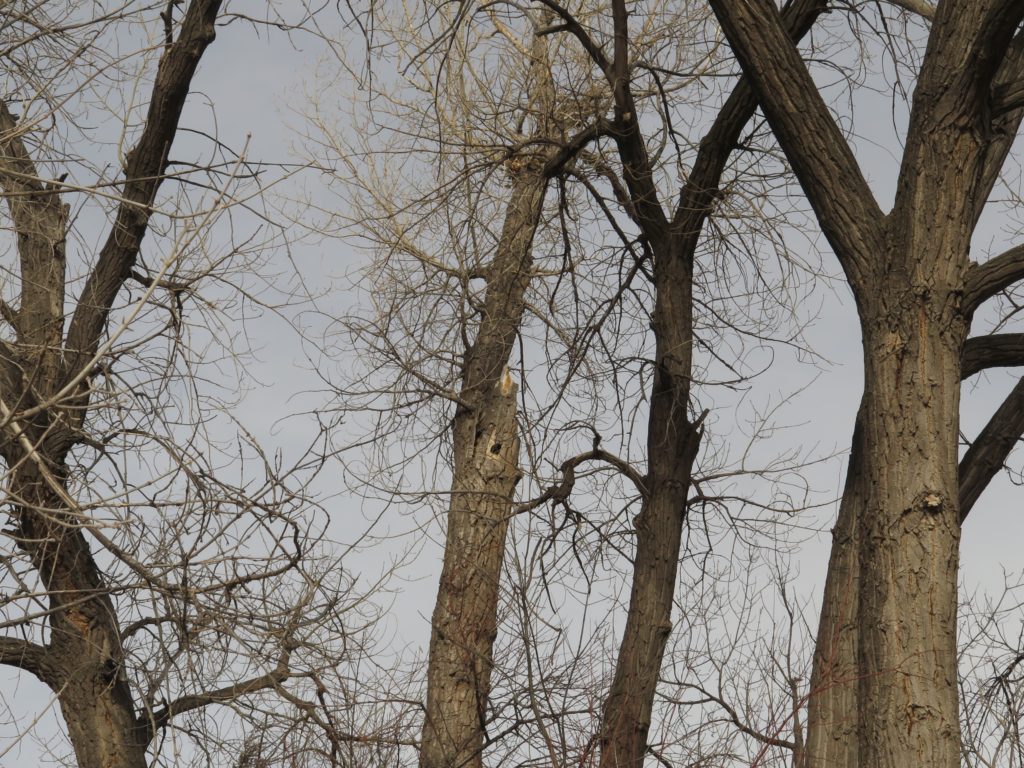
Humans have borrowed the idea of nesting to mean making a cozy home. Humans don’t “nest” just to breed, although expectant or expecting-to-be-expectant parents might fix up their homes to make them more suitable for raising children. Often, nesting is related to décor and the desire to make one’s home a refuge from the busy, workday world. I found over 800 shops with “nest” in their name on the crafting and vintage platform etsy.com alone. Looked at that way, nesting is about creating a habitat conducive to survival for humans and birds alike.
Nesting is a reverse example of anthropomorphizing, the term for placing—some say imposing––human characteristics on other-than-human objects, creatures, and landscapes. Anthropomorphizing can be a form of privileging human actions and agency over all others and reducing the intelligence and consciousness of other beings to what is only observable or understandable by humans.
Scientists have generally denigrated the practice of anthropomorphizing as lacking objectivity or overlaying behaviors with conscious intent, but more recently some scientists have acknowledged that animals may exhibit the kinds of emotions or intentions associated with humans. Further, emotions like empathy between researcher and animal are recognized as important to the understanding of animal capabilities and conducive to the research relationship itself.
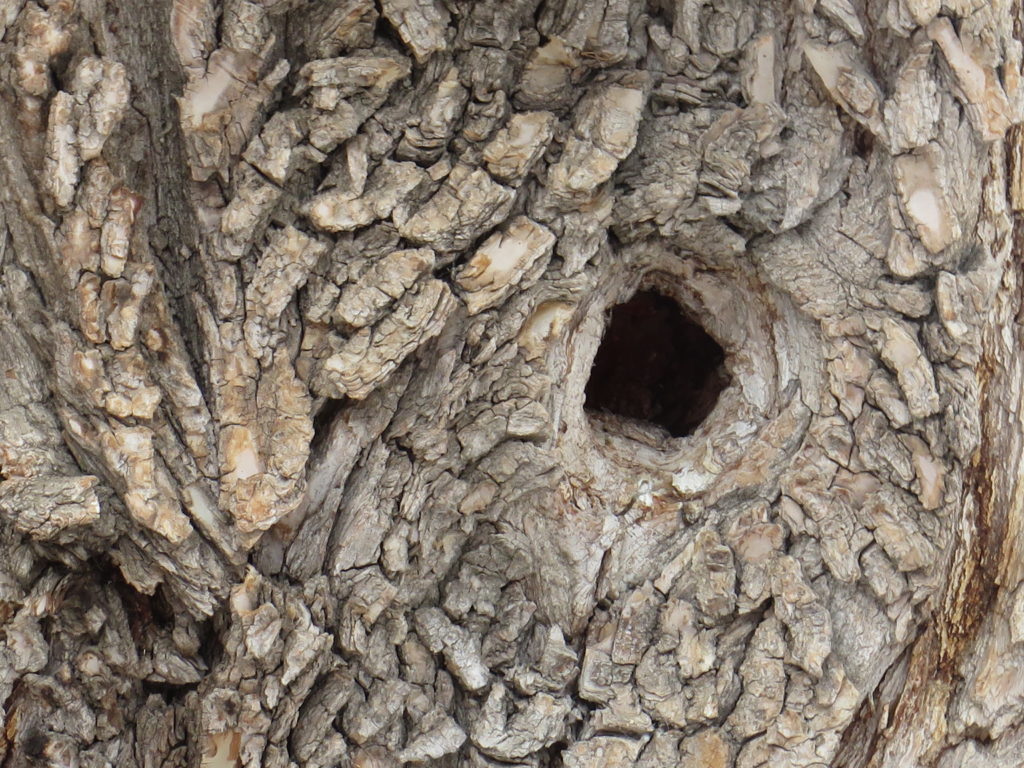
In borrowing the idea of nesting from birds, we could say nesting is a human concept that has been ecopomorphized from an animal practice. As the opposite of anthropomorphizing human characteristics on other beings in the natural world, ecopomorphizing adopts the habits of animals or plants onto human behaviors. This adaptation may be practical, experiential, or metaphorical, but all begin with an other-than-human trait.
By recognizing the basis in nature of ecopomorphizing relationships, humans hopefully learn to empathize with other-than-human beings through gaining insight into their needs, habitats, and characteristics. Through ecopomorphizing we can also expand our care for and about the natural world through acknowledging our mutual interests with creatures, plants, soil, rock, water, and air.

Which brings me back to our broom-nesting robin. When I told a friend the story, he said, “We can learn a lot from that bird.”
“Like how to build a nest!” I joked, but I didn’t mean to be glib. Nest-building is an admirable skill, requiring the ability to find the right location and materials, as well as knowledge of construction techniques to ensure strength, safety, and warmth.
But nest-building means more than that. My friend was right. From that robin, we realized our mutual concerns for protection of habitat and family. Even our need to use the broom and bucket was superseded by our empathy with the bird and its chicks. Our kinship may have been temporary, but in our shared space, we went about our daily lives, coming and going, crossing paths, trusting that the land could support all our nests in kind.
Writing Exploration: In answer to the question “If you were a bird, where would you nest?”, write about aspects of nesting you share with birds in making your own home. How might starting with an actual bird’s habits and habitats influence how you think about home and shelter differently? To learn more about the birds around you, consult the Audubon Society or other birding organizations’ websites for your area.
Next, think about examples of ecopomorphizing with which you are familiar. Nesting, rootedness, and hibernation are a few. Describe the ideas or practices borrowed from nature you recognize in your own life. How does acknowledging them open new perspectives on mutual needs and concerns shared with others in the natural world?
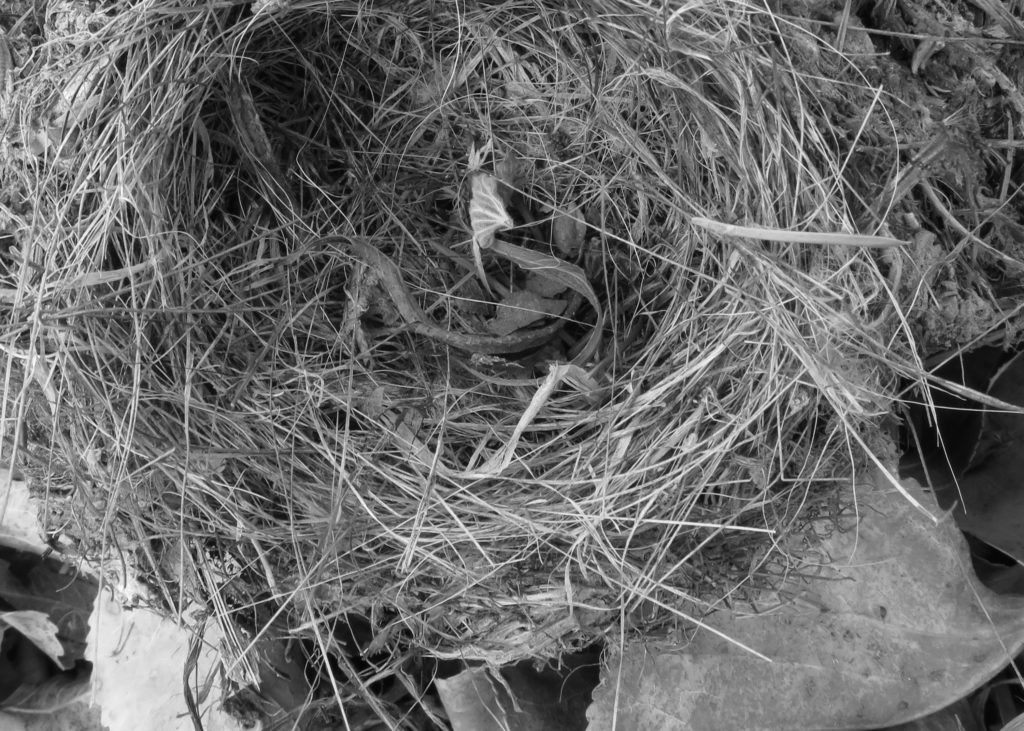
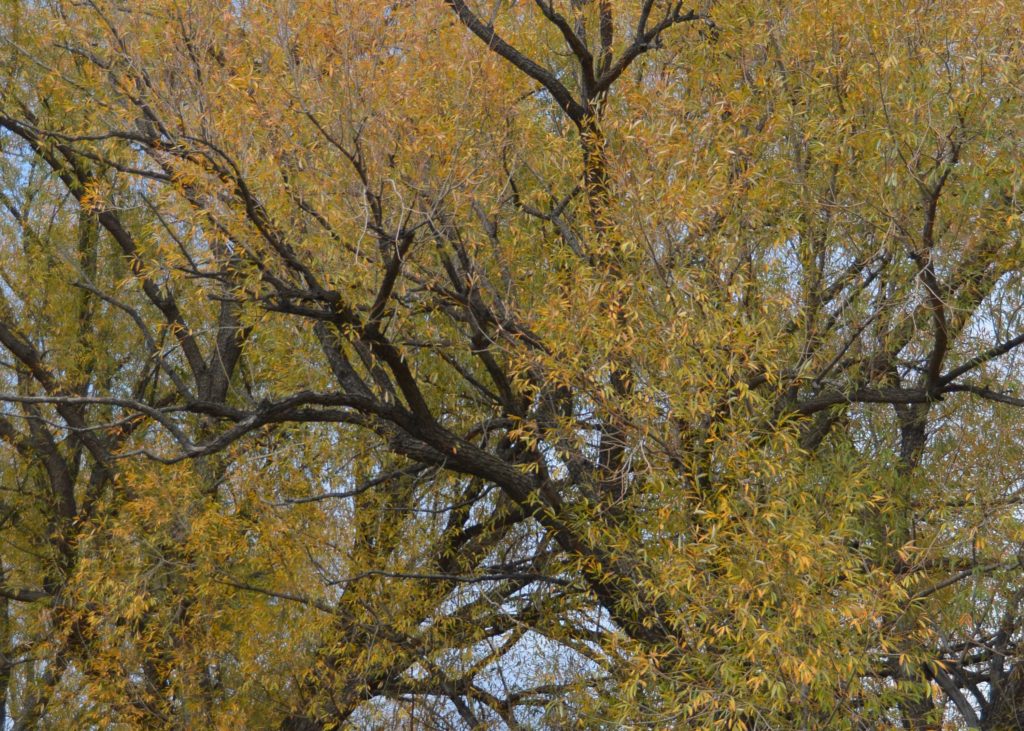
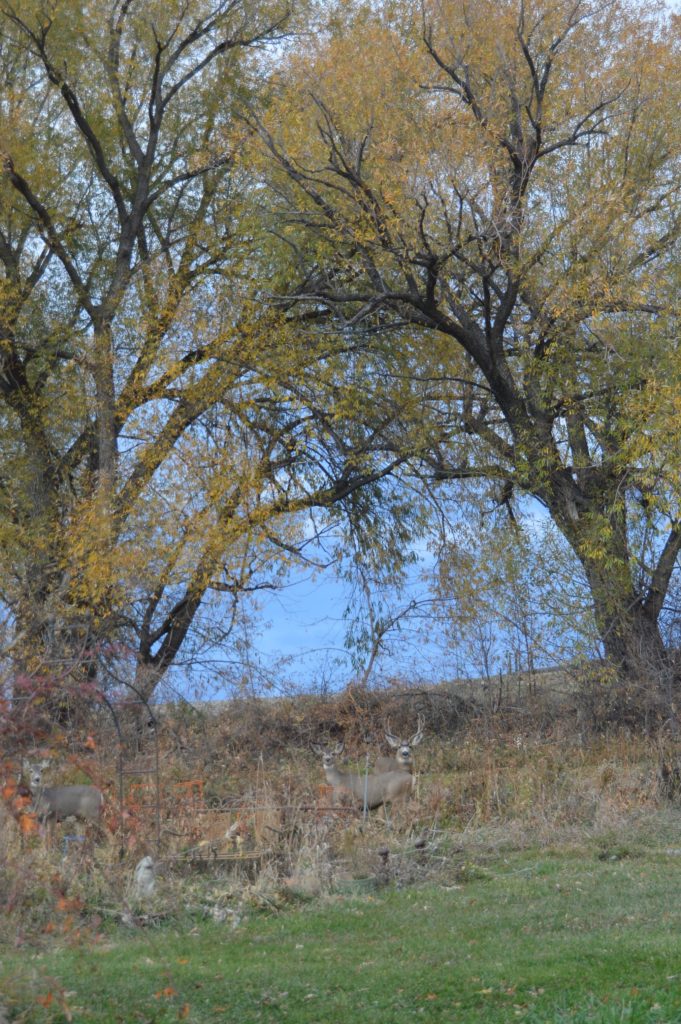
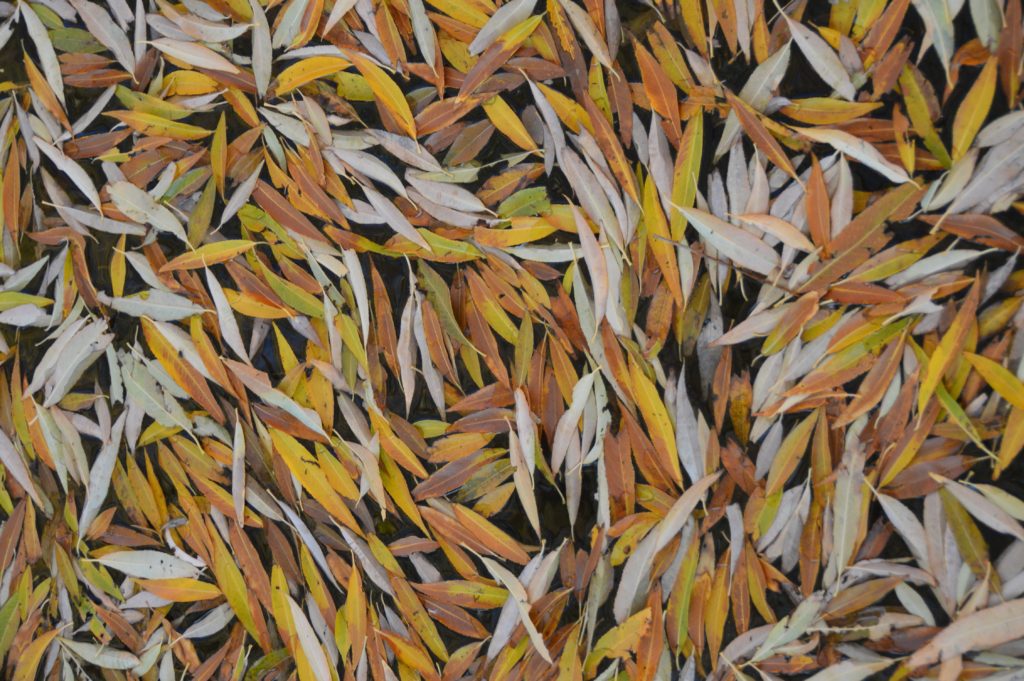
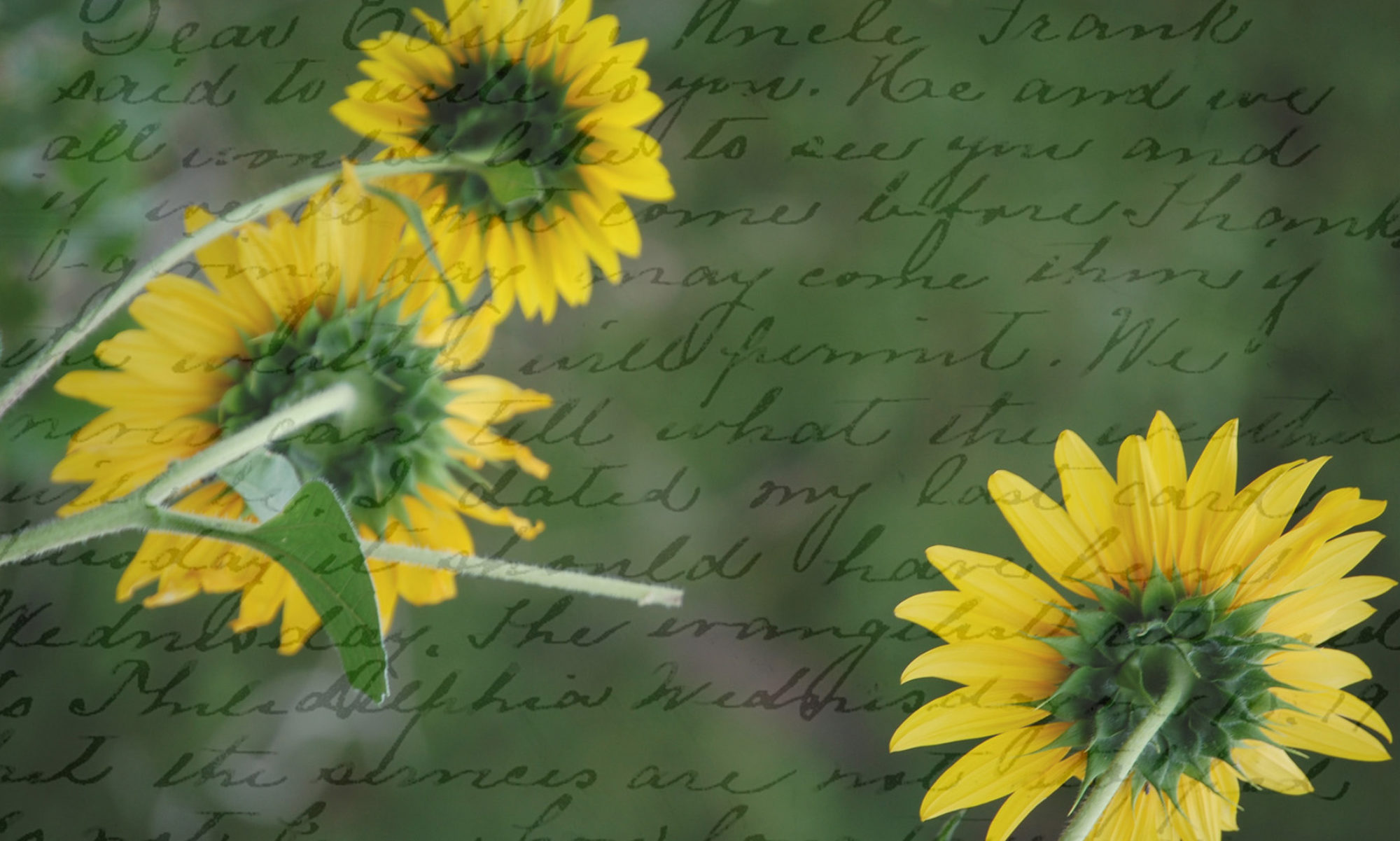







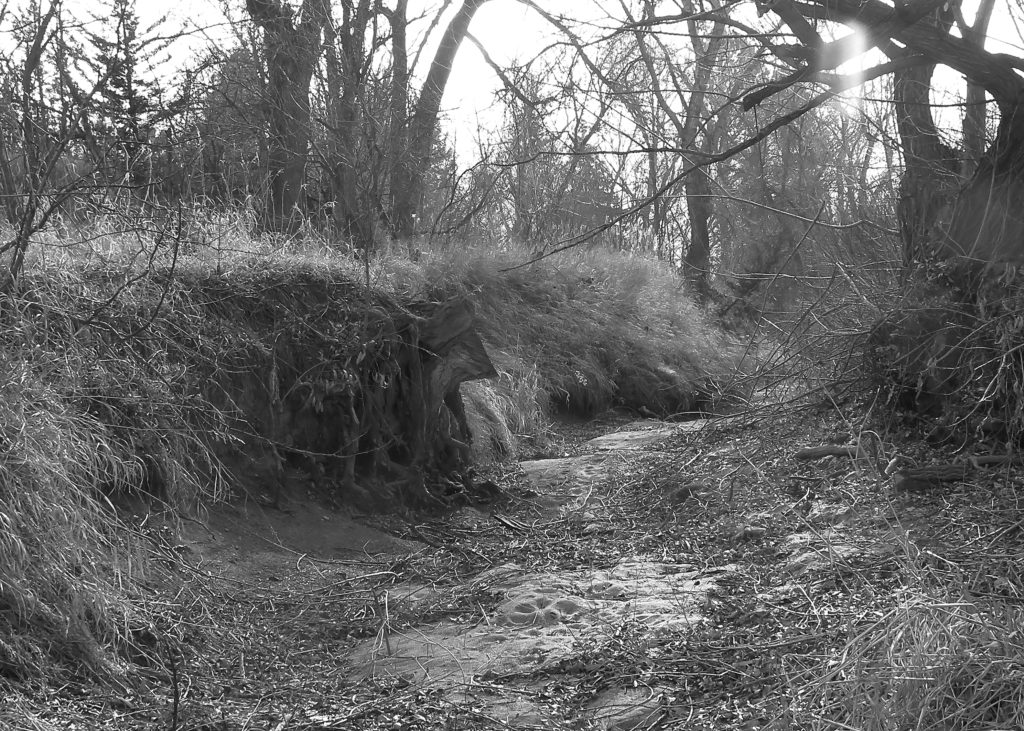
 The night before our ditch adventure, we read Signs Along the River by Kayo Robertson, a children’s book about using the five senses to find the evidence creatures leave behind like tracks, trails, bones, and, to put it plainly, poop. With these clues in mind, we set out the next morning from the bridge over the Rough & Ready to see what we can find. That bridge is next to our swimming hole, a place we often see muskrats paddling when the water’s flowing. Not far from the bridge we find the mouth of a burrow and imagine cozy muskrats in hibernation up inside the ditch bank behind the hole.
The night before our ditch adventure, we read Signs Along the River by Kayo Robertson, a children’s book about using the five senses to find the evidence creatures leave behind like tracks, trails, bones, and, to put it plainly, poop. With these clues in mind, we set out the next morning from the bridge over the Rough & Ready to see what we can find. That bridge is next to our swimming hole, a place we often see muskrats paddling when the water’s flowing. Not far from the bridge we find the mouth of a burrow and imagine cozy muskrats in hibernation up inside the ditch bank behind the hole.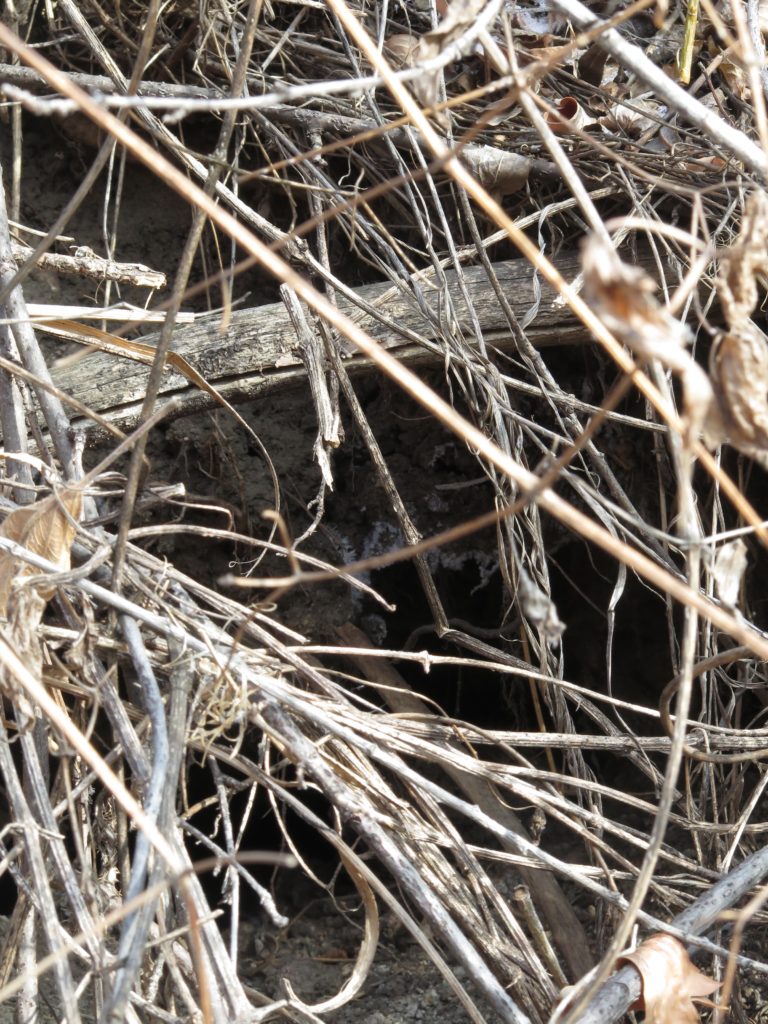 The topography of an empty ditch is a meeting of curves and lines as the flowing water follows the natural limestone walls created over thousands of years, exposing textures of grass, sand, and roots along the ditch’s perimeter. A tree too close to the edge that was felled before our time left a tapestry of tangled roots that now fortifies the bank from erosion.
The topography of an empty ditch is a meeting of curves and lines as the flowing water follows the natural limestone walls created over thousands of years, exposing textures of grass, sand, and roots along the ditch’s perimeter. A tree too close to the edge that was felled before our time left a tapestry of tangled roots that now fortifies the bank from erosion.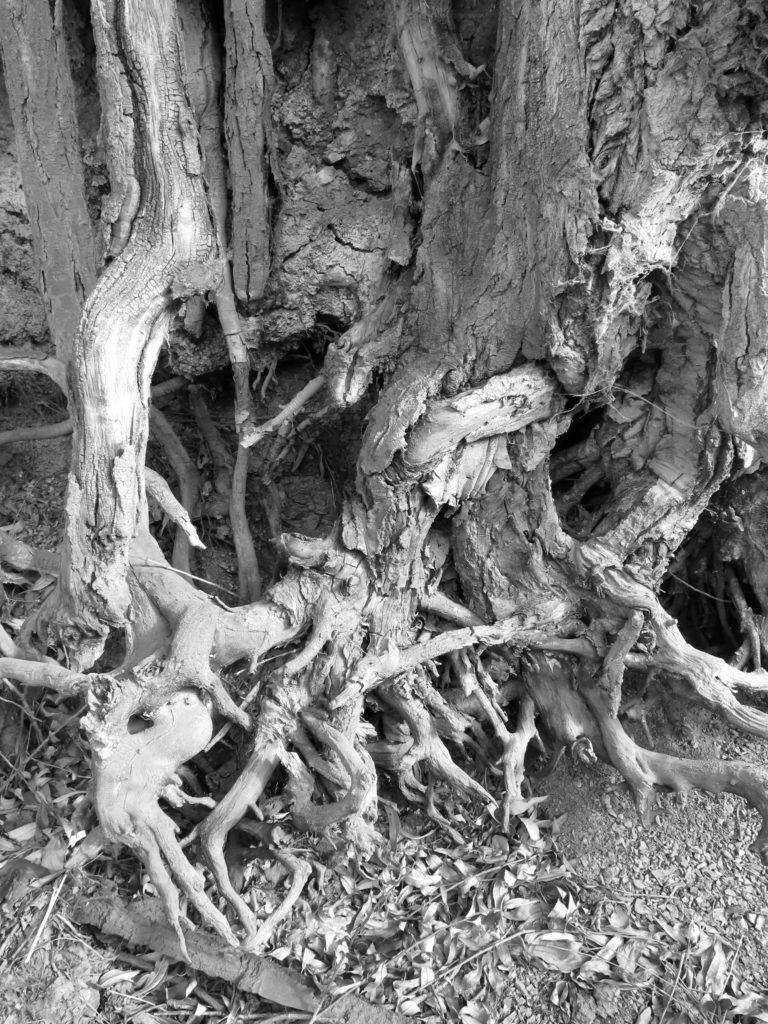 Near another bridge, my grandson spots tracks in the dry sand along the ditch bottom, with many tracks in one spot as if an animal were circling. “What do you think it was?” I ask him. “Coyotes,” he guesses, and he is right because next to the tracks we are delighted to find coyote poop. Coyotes are a constant at the farm; it’s no surprise they run the empty ditches as winter highways.
Near another bridge, my grandson spots tracks in the dry sand along the ditch bottom, with many tracks in one spot as if an animal were circling. “What do you think it was?” I ask him. “Coyotes,” he guesses, and he is right because next to the tracks we are delighted to find coyote poop. Coyotes are a constant at the farm; it’s no surprise they run the empty ditches as winter highways.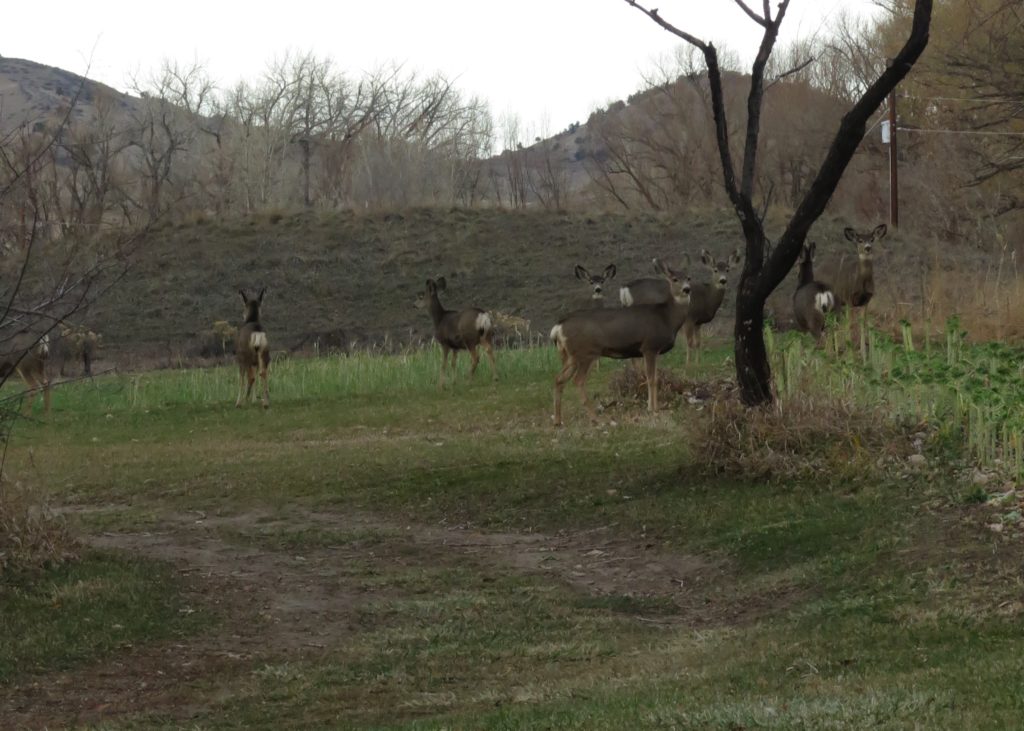 My grandson and I walked the Rough and Ready from one end to the other and back again, stopping to explore whatever caught our eye, including an aluminum baseball bat half-buried in silt and grass, a relic of the flood, perhaps, like the eight-ball we exhumed from a different ditch last spring. In the 20-some years I’ve lived at Stonebridge, I’ve never walked the ditch from end to end before. Seeing it from the inside out was like opening a door to a new room in my house that I hadn’t known existed and realizing that life went on there, with or without me. Now I know that the winter ditch is something I’ve been missing.
My grandson and I walked the Rough and Ready from one end to the other and back again, stopping to explore whatever caught our eye, including an aluminum baseball bat half-buried in silt and grass, a relic of the flood, perhaps, like the eight-ball we exhumed from a different ditch last spring. In the 20-some years I’ve lived at Stonebridge, I’ve never walked the ditch from end to end before. Seeing it from the inside out was like opening a door to a new room in my house that I hadn’t known existed and realizing that life went on there, with or without me. Now I know that the winter ditch is something I’ve been missing.